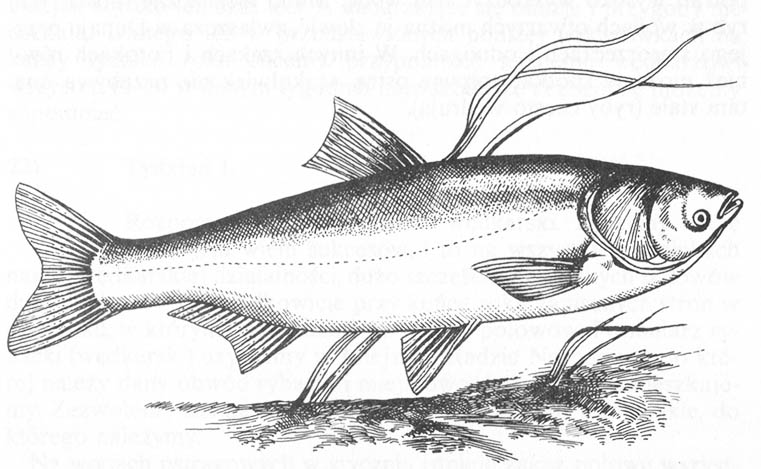
Tołpyga biała, podobnie jak amur biały, należy do ryb sprowadzonych z zagranicy na początku lat 60 i produkowanych głównie w stawach. Ojczyzną tołpygi białej jest Azja Wschodnia (głównie Chiny), zwłaszcza rzeka Amur i jej dorzecze. Ryba ta odżywia się glonami oraz planktonem roślinnym (fitoplanktonem). Barwa jej ciała jest srebrzysta. Na spodniej, brzusznej stronie ciała tołpyga biała ma ostry kil, pozbawiony łusek; jest to cecha, po której łatwo można rozpoznać tę rybę. Oczy są położone niezwykle nisko. W płetwie grzbietowej brak promienia twardego. Tempo wzrostu ma bardzo szybkie; ryby te osiągają 1 m długości i masę ponad 8 kg. Pod względem charakteru odżywiania tołpyga jest wegetarianką, ponieważ w olbrzymich ilościach konsumuje plankton roślinny (glony), który w nadmiarze jest niepożądany, zwłaszcza w stawach rybnych. Tołpygę spotyka się sporadycznie; w najbliższej przyszłości planuje się zarybienie nią wód w rejonach przydunajskich.
Ze względu na rzadkie występowanie tej ryby specjalizowanie się w jej połowach należy uważać za przedwczesne. Trafia na wędkę najczęściej przypadkowo podczas łowienia innych ryb karpiowatych (zwłaszcza karpi). Mimo że tołpyga odżywia się głównie roślinnością wodną, wykorzystuje każdą okazję do spożywania pokarmów innego rodzaju, w danym momencie bardziej atrakcyjnych, smaczniejszych, przez co istnieją pewne szanse zanęcania czy podsuwania jej określonych przynęt. Z doświadczeń krajowych i zagranicznych wynika, że dobrze bierze na gotowaną kukurydzę, pszenicę, kaszę kukurydzianą, ale zawsze po uprzednim intensywnym zanęcaniu. W zasadzie bierze od wiosny do jesieni. Zdarzało się też złowienie tołpygi białej na błystkę. Ryba ta jest ceniona przez wędkarzy nie tylko ze względu na znaczną masę poławianych sztuk, ale także za bojowość i siłę, z jaką walczy o życie. Jej mięso jest bardzo smaczne; po złowieniu należy natychmiast ją wypatroszyć i usunąć wnętrzności. W przeciwnym razie mięso gorzknieje i szybko się psuje. Przy obróbce kuchennej należy pamiętać o usunięciu — podobnie jak u amurów — złogów tłuszczu, gdyż dzięki temu istotnie poprawia się smak przyrządzanego mięsa (rada 220).
Tołpyga pstra jest bliską krewniaczką tołpygi białej, również pochodzącej z południowo-wschodniej Azji (głównie Chin). Ze względu na marmurkowe ubarwienie ciała Niemcy nazwali ją karpiem marmurkowym (Marmorkarpfen). Tołpyga pstra odżywia się zasadniczo przez całe życie planktonem zwierzęcym, sporadycznie tylko roślinnym (jest to pokarm dodatkowy i przypadkowy). Tempo jej wzrostu jest także szybkie, przy czym może ona osiągać jeszcze większe rozmiary aniżeli tołpyga biała. Prowadzi tryb życia podobny lub taki sam jak tołpyga biała. Jest bardziej płochliwa i ostrożniejsza od innych karpiowatych, dlatego też w czasie jej połowu należy zachowywać się niezmiernie ostrożnie i cicho. Pod wpływem nagłego stuku lub pluśnięcia wiosłem — bądź gdy na wodę padnie cień — tołpyga pstra potrafi wysoko wyskoczyć nad wodę. Mimo nieznacznej ilości tych ryb w wodach otwartych można je złowić, zwłaszcza w Dunaju oraz jego starorzeczach i odnogach. W innych rzekach i potokach również możemy spotkać tołpygę pstrą, aczkolwiek nie przebywa ona tam stale (ryby często wędrują).